6 Best HomeKit Routers in 2025 [Highly Compatible]

If you prefer Apple Home to control all your smart appliances securely, you will need a HomeKit-compatible router. Unfortunately, not all routing devices work with it. However, there are some options available, particularly mesh WiFi systems.
There is a lot more to ensure than just compatibility, such as WiFi not dropping, speeds being consistent, and smart devices responding properly. Some connectivity issues can cause frustration even after a costly investment.
That’s why I have tested all the supported models and have reviewed only those that function flawlessly in every aspect.
Want to save money when shopping online? Checkout:
- EarnIn: Borrow up to $750 against an upcoming paycheck!
- Capital One Shopping: Automatically apply available coupon codes online to find deals and save!
6 Best Routers for Apple HomeKit in 2025
To find you appropriate choices, I observed each device for HomeKit management and other aspects like speed, coverage, device-handling ability, security features, ease of use, etc. After detailed tests, here are my top 6 picks for you to make an informed decision. Without further ado, let’s dig in!
1. Best Overall: Linksys MX12600
If you’ve loads of smart devices installed in your Apple HomeKit ecosystem, Linksys MX12600 is the best you can get. With tri-band Wi-Fi 6, a massive 8,100 Sq Ft range, AX4200 speed, and multiple device-handling capacities, it ensures none of your smart home is void of internet connection.
Besides, MX12600 takes a few steps ahead of its predecessor, Linksys AX3200 in terms of speed, range, and more.
Speeds & Performance
Linksys MX12600 has an aggregated speed of 4200 Mbps, and each band can reach data rates of up to:
| 5 GHz (1): 2404 Mbps | 5 GHz (2): 1201 Mbps | 2.4 GHz: 574 Mbps |
Velop turned out great in my throughput tests with Xfinity Gigabit Internet. The primary router node notched a score of 912 Mbps for downloads and 36 Mbps for uploads in close proximity, i.e., 20 feet.
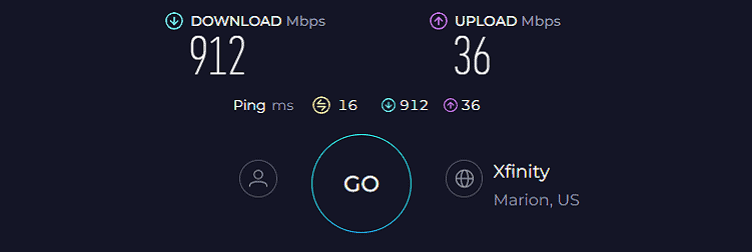
And over a 60 feet long distance, the respective speeds clocked at 638 Mbps and 26 Mbps. That’s the highest for all the routers I have tested with HomeKit devices. During a week of watching videos, playing games, sending emails, and downloading large files, the Velop AX4200 performed smoothly.
I could stream 4K videos on my Apple 4K TV, attend video calls on my MacBook, and play online games on my iPhone 13 simultaneously without any freezes or artifacts.
WiFi Coverage & Devices Capacity
Being one of the top-rated mesh systems, wireless coverage is its standout aspect as its 3-unit pack claims to cover a whopping 8,100 Sq Ft area.
To test it out, I went to my friend’s three-story house whose study room on the top floor and garage outside has the worst coverage.
But, with the mesh router installed on the second floor, there weren’t any network dead spots left, and a 6,100 Sq Ft area was easily covered. And with Intelligent mesh tech, signal strength was almost identical in most areas.
Added to it, the MU-MIMO and OFDMA work to stabilize the signals transmitted to multiple devices. Most of my and my friend’s smart devices (including Apple) like laptops, smart lights, TVs, computers, and others adding up to 75 went lag-free.
Security Features
HomeKit support in Linksys MX12600 allows it to be managed through the home app on iPad, iPhone, and Mac. There are three security options: restricted, automatic, and non-restricted mode.
In my two weeks of use, the experience with them was excellent. With the restricted option turned on, I could lock down devices, thereby keeping my Apple smart devices away from the risk of compromising by communicating with external devices.
It’d be better to stay on the default automatic option to connect with devices outside the Apple ecosystem and stay safe at the same time.
Besides, the router has a few in-built security features like WPA3, SPI firewall, VPN, guest network, and auto-firmware update to create a safe passage for data transfer from the router to connected devices.
Conclusion
Linksys AX4200 is the best possible HomeKit router on offer. It ensures all your smart gadgets are up and running throughout the day. Its only drawback is its high price, but its flagship-grade features and stable internet connection make every penny worth it.
Pros
- Tri-band Wi-Fi 6 setup
- Excellent throughput
- Exceptional WiFi coverage
- No network drops
- Three-year warranty
Cons
- Expensive
2. Best Runner-Up: AmpliFi Alien
If the speeds available with my top pick aren’t enough for you, look at this AmpliFi Alien mesh system. Like something out of “2001: A Space Odyssey”, this device offers an onboard touch screen, but most importantly, the throughput tests on both nodes turned out excellent.
Speeds & Performance
AmpliFi Alien is a tri-band WiFi 6 mesh system with a maximum data transmission ability of 7685 Mbps, with speed on each band as follows:
| 5 GHz (1): 4804 Mbps | 5 GHz (2): 1733 Mbps | 2.4 GHz: 1148 Mbps |
With the mesh system installed on respective floors of my mansion-style house and Apple Macbook M2 (15”) as a connected client during peak hours, it turned into excellent numbers.
With 20 feet between the router and the receiving client device, the Ookla speed test app recorded a throughput of 932 Mbps for downloads and 33 Mbps for uploads.
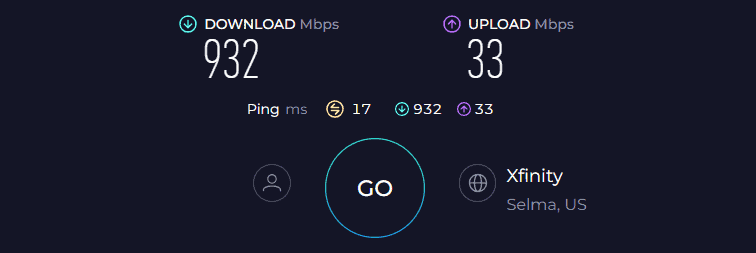
At about 40 feet, the respective speeds dropped to 545 Mbps and 21 Mbps. Please note here I used the Comcast Xfinity 1 Gig plan to measure the speeds. AmpliFi managed around 18% more bandwidth than Gigabit mesh systems out there.
And so it easily passed my informal saturation test where I streamed 4K video on my iPad Pro (5th gen) and HD videos on my Macbook M2, while an iPhone 14 Pro played an internet radio station as I downloaded data on my Apple TV.
None of the video or audio streams were interrupted or encountered any skips or freeze-ups.
WiFi Coverage & Devices Capacity
On paper, the two-piece kit of AmpliFi Alien comes in a range of 6,000 Sq Ft, which stays clear of most WiFi 6 standalone routers and mesh systems.
With seamless connection between the router and its nodes, it could cover a maximum area of 5,300 Sq Ft, viable for a large commercial establishment.
Not only that, I could connect up to 63 Apple smart devices without dropping the signals. Its OFDMA and MU-MIMO do wonders when it comes to connecting multiple devices to the bandwidth at once.
Security Features
The best part about AmpliFi Alien is its support for the newly launched Apple devices, up to the iPhone 14 Pro Max, Macbook Air M2, and iPad Pro (5th gen). With upcoming updates, it will support even the latest devices.
With the availability of the aforementioned devices, I tested each possible feature, and my overall experience was excellent. I now have greater control over the access capabilities of my smart home devices.
The possibilities are endless. I can browse key diagnostic information like download/upload activity, connected devices summary, IP address, and real-time network speed data.
Besides, I can provide remote access to visiting family or friends and control my family’s screen time. These, combined with WPA2, VPN, and others, pave the way towards worry-free browsing.
Conclusion
AmpliFi Alien might be the costliest, but it fits the bill as an upgrade pick for your HomeKit ecosystem. Compared to most mesh systems, the features it locks internally ensure a strong performance throughout. Besides, its support for HomeKit betters others.
Pros
- Wi-Fi 6 + Tri-Band
- Excellent speeds
- Great wireless range
- Simple setup
Cons
- Expensive
3. Best for Streaming: Eero Pro 6
A souped-up version of Eero 6, the Pro 6 adds in an extra band, added coverage, and a new Zigbee radio that lets Alexa users pair smart locks and lights without any additional hub hardware.
Like most mesh networks, it uses multiple nodes to send strong signals throughout a large house, and the result is a more robust network with fewer dead zones.
Speeds & Performance
As compared to Eero 6, it comes at an increased throughput capacity of 4200 Mbps, which is distributed over its three bands as follows:
| 5 GHz (1): 2402 Mbps | 5 GHz (2): 1201 Mbps | 2.4 GHz: 574 Mbps |
With the router and test system 20 feet apart, the Pro 6’s bandwidth caught up with others at 906 Mbps for downloads and 34 Mbps for uploads respectively with the same Xfinity Gigabit plan as my previous pick.
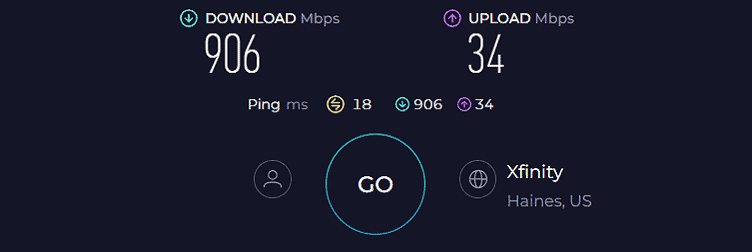
Meanwhile, at 60 feet, the respective speed dropped to 633 Mbps and 25 Mbps. And in the detached garage, the downloads maxed out at 109 Mbps.
With such speeds in hand, my mini workstation in the garage consisting of Apple laptops, computers, and smartphones remained operational.
Aside from that, my brother engaged in hours of gaming and video binging without any buffers or frame freezes.
WiFi Coverage & Devices Capacity
On paper, the Eero Pro 6 comes at a range of 3,500 Sq Ft, which is much ahead of many Wi-Fi 6 systems. And with a node connected, it could reach a maximum area of 3,200 Sq Ft, ideal for a two-story house.
I could connect up to 48 devices to the bandwidth without dropping the signals. Thanks to MU-MIMO and OFDMA, they work wonders when it comes to handling multiple devices.
Security Features
With HomeKit support in Eero Pro 6, you have greater control over the access capabilities of your smart home devices.
With it, I can make it work in any way possible like hindering communication with external devices at any time or providing it the flexibility to work on its own and decide which devices are safe to communicate with.
It comes in handy for people with minimal technical knowledge as well as not being able to compromise the data they’re working with.
Aside from that, the in-built security features of this mesh system include a staple WPA3, a TLS to establish a secure path for the data to travel, and a VPN to remotely browse anything. These act as a cherry on top.
Conclusion
With strong performance, Eero Pro 6 fits the bill as an excellent WiFi system for your HomeKit ecosystem. But only two Ethernet ports limit its wired connectivity options. For more specific details, check out my complete Eero Pro 6 review.
Pros
- Wi-Fi 6 + Tri-Band
- Great wireless range
- Excellent speeds
- Easy fast setup
- Zigbee smart home hub
Cons
- Two Ethernet ports
4. Best for Gaming: Linksys MX8000
Next on my list is another Linksys mesh router that is certified for use with Apple HomeKit. MX8000 comes with a tri-band Wi-Fi 6 setup, a WiFi range of 5,400 Sq Ft, and a couple of ports for faster-wired connections. Noticeably, it brings a longer range than my previous recommendation.
Speeds & Performance
Linksys MX8000 is a tri-band mesh with an aggregated speed of AX4000, which is the combined speed of two 5 GHz and one 2.4 GHz bands as follows:
| 5 GHz (1): 2400 Mbps | 5 GHz (2): 1200 Mbps | 2.4 GHz: 600 Mbps |
I paired it with my staple Xfinity 1 Gbps plan, and the results were impressive:
Near the system at around 20 feet, the download and upload speeds were 896 Mbps and 33 Mbps, respectively.
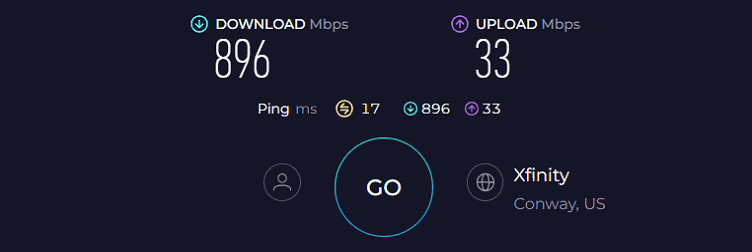
When I moved to 60 feet distance, the respective speeds dropped to 625 Mbps and 23 Mbps, respectively.
While away in the garden, the speed was around 98 Mbps for downloads. Such high speed even in distant areas makes it an ideal mesh WiFi for gaming, 4K/8K streaming, and other bandwidth-hogging activities.
WiFi Coverage & Devices Capacity
As per the manufacturer, the maximum area this Linksys system can cover is up to 5,400 Sq Ft. Thanks to its beamforming antennas, signals penetrated through the thick walls to have a signal overhaul around my 3,700 Sq Ft house. And trust me, there weren’t any major speed drops in any areas.
As for connection handling ability, I could connect up to 58 smart devices with ease. Its OFDMA tech works to minimize latency in most scenarios, which takes your gaming experience to the next level.
Security Features
With restricted and automatic modes, the routing device detects which device is safe to communicate with.
The best part with automatic mode is, that you don’t have to alter any setting as HomeKit self-assess the network that’s trying to communicate to deem if it’s safe or not.
Right out of the box, it includes WPA2 / WPA3 security to keep the databases and passwords safe and secure. There’s a VPN and access control feature to ensure a safe internet experience.
Conclusion
Overall, MX8000 performs well in all regards. The mesh router had zero difficulties sending strong signals in a large house. Easy installation, HomeKit compatibility, and others add a few points. But at $400, it’s on the expensive side.
If you want to learn more, check out the detailed Linksys MX8000 review.
Pros
- Wi-Fi 6 + Tri-Band
- Good selection of ports
- Faster speeds
- Great WiFi range
- Decent security
Cons
- Still pricey
5. Best WiFi 5 Mesh: Linksys Velop WHW0302
Next on my list is another Linksys Velop that shares tri-band support like its siblings for more usable speeds. Aside from that it shares a decent throughput capacity range, and the ability to handle many devices despite its rather old Wi-Fi 5 standard.
Compared to its predecessor, it takes a few steps ahead with an extra band, added throughput, and range.
Speeds & Performance
The WHW0302 comes with a speed rating of AC2200 and its band-wise speed share is as follows:
| 5 GHz (1): 867 Mbps | 5 GHz (2): 867 Mbps | 2.4 GHz: 400 Mbps |
In my Nashville Lab’s real-time testing with iPhone 13 and Xfinity 800 Mbps plan, a single Velop unit acting as a router can push an average download speed of 716 Mbps and 29 Mbps for upload at 20 feet.
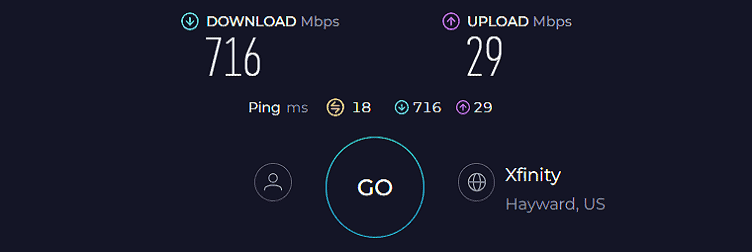
Unfortunately, the speeds dropped when I moved 60 feet away from the router. The respective values for downloads and uploads averaged 498 Mbps and 21 Mbps.
But compared to my top recommendations, I found the Linksys Velop rather inconsistent. It turned out unreliable when travelling through complicated configurations like walls or multiple signals.
In my near-to-ideal test setup, however, this wasn’t the case. I played online games on my PS5, streamed UHD videos online, and filed my taxes at the same time without any issues. The performance wasn’t top shelf but still, it managed well.
WiFi Coverage & Devices Capacity
Coverage-wise, it stoops ahead of Eero Pro 6 with a theoretical value of 4,000 Sq Ft. Despite a few inconsistencies here and there, the mesh system manages a strong throughput in a 3,600 Sq Ft area.
As evident on my WiFi analyzer app, the signals were decent enough in the nooks to handle any internet-bound tasks without much effort.
Aside from that, the MU-MIMO and OFDMA tech lets me connect up to 34 Apple smart devices, including smart TVs, laptops, smartphones, and computers.
Security Features
Support for HomeKit was especially beneficial in preventing hacking attempts and ensuring the home devices are more secure. As with most of my recommendations, you have three modes to regulate the security of your smart devices.
But it’s lacking majorly in terms of in-built security as it only has features like VPN, WPA3, and access control.
Conclusion
With its powerful antennas, Linksys Velop easily fills up a large home with strong WiFi signals, but it isn’t the fastest or most consistent router. But around $170, it stays ahead of many expensive kits available.
Overall, the performance you get should be enough to keep most devices in your large spaces up and running.
Pros
- Great WiFi range
- Decent wireless speeds
- Handles many devices
- Easy to install
Cons
- Wi-Fi 5 standard
6. Best Budget Option: Eero 6
As I have reached the end of my list, presenting you with a budget option, Eero 6. It has quite a few surprises, the notable being a dual-band Wi-Fi 6 that doubles the speed of a legacy 802.11ac connection, and most smart device supports it.
Compared to the previous generation Eeros, it’s much faster and transmits signals to a much larger space.
Speeds & Performance
The device comes at a theoretical speed cap of 1800 Mbps where each band has a speed cap of:
| 5 GHz: 1200 Mbps | 2.4 GHz: 600 Mbps |
Looking at the individual band speeds, the Eero 6 comes as a superior model to the Linksys Velop router. To test out if it does better than the latter, I subjected it to a real-time residential space with thick walls and signal interferences.
With an Xfinity 500 Mbps plan, the Eero 6 registered a 417 Mbps download and 21 Mbps upload speed at a 20 feet distance.
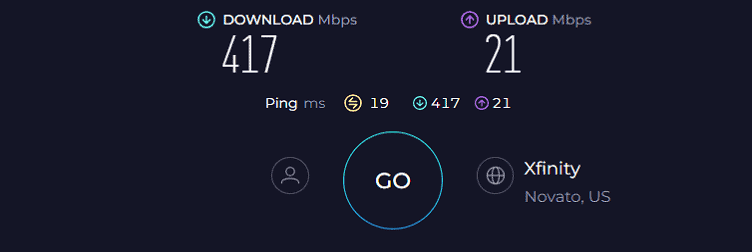
While moving 60 feet apart, the respective speeds were around 292 Mbps and 15 Mbps.
Such a speedy connection even keeps the most gadget-crazy homes happy for years to come. Besides, to test its performance, I put it to the saturation test with online games playing on my PS5, and UHD video streaming on my Macbook.
Although games had a 42ms ping with minor lags and latencies, others went like a breeze.
WiFi Coverage & Devices Capacity
The Eero 6 with a single node is estimated to cover a 3,000 Sq Ft area. So I installed it in my 2,500 Sq Ft test lab in Nashville, and to my surprise, its nooks, and crooks were filled with strong WiFi signals.
And the best part is, the signals in the corners can handle a UHD video stream without any buffering. Moving on, the mesh router is designed to stream data efficiently to up to 48 smart home devices simultaneously, courtesy of MU-MIMO.
Security Features
With HomeKit compatibility, I could set the Eero 6 to communicate with my Apple devices and/or other smart devices, as with the top recommendations on my list.
But make sure to use it aptly to not hinder the security updates which is the case with restricted mode or not compromise it by letting it communicate with other devices with no restricted mode.
Other than that, the default security settings on Eero 6 include WPA3/WPA2 mixed encryption, guest network, and access control to keep your data secure.
Conclusion
To conclude, Eero 6 is an ideal budget-friendly option for faster speeds over a large area. With fewer security settings, it comes in handy to prevent attacks from malware, viruses, and other external agents of a standard home. But one less band and middling range have pushed it to the bottom of the list.
Pros
- Wi-Fi 6 support
- Compact design
- Great throughput
- Decent WiFi range
- Easy to install
Cons
- Dual-band support
Frequently Asked Questions
Do I need a special router for HomeKit?
Yes, only a few routers in the market are supported by HomeKit, so you must check compatibility with it before investing in one.
How do I add a router to Apple HomeKit?
Follow the step-wise process:
Step 1: Log in to the router’s panel.
Step 2: Tap on the menu icon on the dashboard followed by the Apple Home integration option.
Step 3: Click on Connect to Apple Home and allow access to home data.
Step 4: Select a home. If there are multiple homes set up, select the current home.
Step 5: Then, click on Add to Home option to link the nodes to the Homekit app.
Step 6: The first detected node is the parent node, press continue and select its location. And if there are any further child nodes, follow the same process.
Step 7: Turn the HomeKit accessory security on and that’s it. Your router is connected to the HomeKit.
Verdict
I hope this list of HomeKit secure routers helped you make an informed decision. If you’re still unsure, here are my final suggestions:
- If you need the best performance and top-notch features, Linksys MX12600 is what you should choose.
- If you can’t afford a costly piece or compromise on its features, you can go for the Eero Pro 6.
- And finally, if you need a basic budget-friendly option, Eero 6 is a good choice.
With that, comes an end to my guide. Goodbye and take care!
